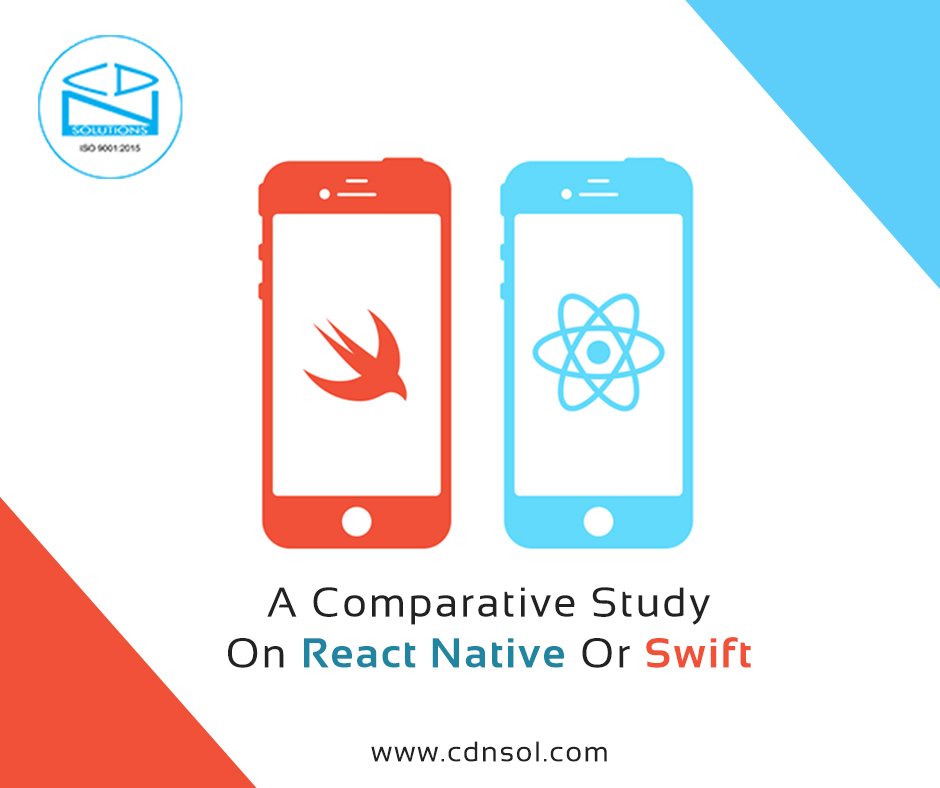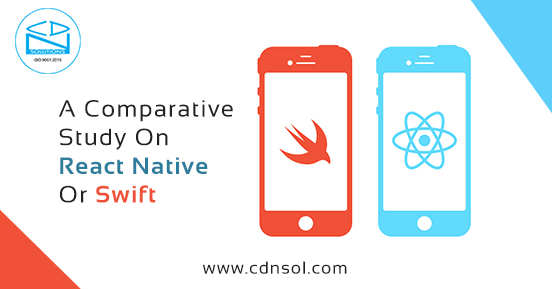
The Mobile application market is becoming quicker than a beanstalk. The industry is gigantic and developing every day, and there is no imaginable closure. Expectedly, the mobile application developer populace has blasted, and the number of mobile applications in the market has hit new statures. The income produced by the worldwide mobile application industry has skyrocketed. In the success of the mobile app industry, two new technologies have played a tremendous role i.e. react native and swift.
React Native and Swift are both new technological advancements that help the mobile application development and improvement. While React Native is a structured framework for JavaScript, Swift is fresh out of the new programming language. So which one to pick when contemplating building a new application? To understand which is best or what should one opt let us understand these two.
Table of Contents
Insight on swift:
Swift is a cutting edge, general-purpose and multi-worldview programming language planned by Apple to construct their iOS-controlled devices and all the accompanying environment. Applications can be intended to run likewise on macOS (for Apple PCs), tvOS (Apple TV computerized media player) and, what might be somewhat astounding z/OS, that is driving IBM Mainframe PCs. The language is presently appropriated on Apache License, which makes it accessible for the network to utilize. It’s a moderately new venture, propelled in June 2014, seven years after the first iPhone’s release.
Insight on react-native:
React Native is a Facebook-supported structure intended to construct gadgets and devices freethinker mobile applications. As opposed to local applications that utilization distinctive programming dialects for every platform, React Native depends on JavaScript and permits clients to share the code between different stages, including Android, iOS and web applications. Up to 70% of the code might be shared between the applications, essentially lessening the improvement time in cross-stage versatile application advancement.
Respond local is generally utilized and built up innovation, utilized by Facebook and Walmart applications among others.
React Native V/S Swift:
Development and advancement process:
The Development and advancement procedure for both react native and iOS is very comparative. The principle contrast is only the request for back to back assignments. One favorable position of React Native over Native iOS is the hour of improvement. For a simple application, for instance, the specialized group found that there is a 30 percent mobile development cost and time effectiveness.
Regarding structure design, react-native technology gives hot reloading that keeps the application running and permits infusing new forms of documents that have been altered, at runtime. This assists with saving the entirety of your states particularly when you are chipping away at the UI.
Clearly, react-native might not have any different segments as Swift. It is an open-source venture, quick picking up ubiquity because of a functioning network and Facebook support. While numerous capacities are as yet inaccessible, a few situations can utilize react-native modules device with an NPMpackages that works for specific issues. Be that as it may, now and again developers should fabricate the necessary modules themselves. For instance, to make shadows work precisely as they do on iOS, there is no custom arrangement to react-native. In this manner, you should change and alter to get the ideal outcomes.
User interface:
Swift, being the iOS-local language framed by Apple to power applications has clearly no issues with coordinating into the iOS design plan and utilizing all the UX standards. Then again, building the application with Swift is, truth be told, coding a local application without any preparation. In this manner, each component should be cleaned independently.
React Native, then again, utilizes JavaScript as a force behind the scene and use the inward APIs to run local components. Taking into account that, the UI is vague with the local one, yet simpler to code. Also, because of the web advancement inheritance of JavaScript, the applications have no issues with being shown on different screen sizes – and that might be a moment that building an application for iPhone and iPad simultaneously.
Execution and performance:
Execution is a significant thought for mobile application services, particularly to see which structure is increasingly proficient. The three fundamental calculates that help concluding this is CPU use apportioned memory and vitality sway for different assignments like accepting a call, the main run, opening a URL. It is likewise critical to take note of the speed of opening and looking over the language rundown to call (outlines every second).
React Native is tantamount to, if worse than Native iOS for CPU use and vitality sway. Applications created with RN will, in general, allot more memory than those written in Swift. It is additionally evident that RN applications hold almost 20 MB of memory for RCTBridge and its different segments. Along these lines, regarding execution, both have comparable conduct and productivity.
Different tests saw among web appear, that when looking at two indistinguishable applications playing out similar activities, the distinctions change from the errand. React Native is somewhat better when coming to CPU use streamlining, yet managing graphical impacts might be progressively problematic for the system. To handle the test, React Native empowers engineers to install the local code into the application, conveying code fabrication utilizing various instruments and advantages for manage various assignments.
Security and stability:
React Native, regardless of being controlled by one of the most famous programming languages, isn’t creating an extremely local application. Its work depends on utilizing the interior APIs and libraries to make the application work. Along these lines, it is tied in with including a middle man between the platform and the code.
Then again, Swift creates a local application, that may use all the platform possibilities. As referenced above, Swift performs better when managing realistic impacts and computational-overwhelming errands. So with regards to squeezing out the platform, Swift might be the better decision. In any case, is each application squeezing out the iPhone? Furthermore, what the number of Swift developers are sufficiently skilled to manufacture the application that is sufficiently advanced to act in a more steady manner than React Native one?
Documentation:
Both React Native and Swift are bolstered and kept up by tech mammoths. React Native is a Facebook-upheld projected task, and Swift undergoes from Apple. Taking into account that, the two activities are all around reported and composed.
The maturity of each platform:
The two projects are generally new, with Swift been propelled in 2014 and React Native in 2015 (being an immediate relative of React.js which has been being used inside Facebook since 2011 and gone open source in 2013). These advances are rising, yet there are not many critical contrasts. Swift is another programming language intended to be the following platform after Objective-C. Structuring a programming language is constantly a prickly procedure, as it is a spine of each bit of programming.
React Native, then again, is the new innovation fuelled by the built-up one – the JavaScript. In this way it is simpler to check the code and recognize the issues with the structure itself and detecting the bugs is simpler.
Cost and Expenses
Numerous new companies have begun considering React Native because of the short advancement cycle and clear cost-effectiveness. react-native is additionally generally simple to learn and simpler to investigate, making the preparation part simpler for organizations. Similarly, as with React Native, you forego the expense of two separate groups for iOS and Android, there is a decrease in the general assets utilized.
Conclusion:
React Native or Swift, The appropriate response lies in the unpredictability of the application. For increasingly complex applications, it is smarter to write in Swift or, in all likelihood, your application basically doesn’t quantify facing the opposition. For less difficult applications, React-Native gives spending plans and the course of events picks up that is difficult to disregard. React Native and Xamarin both have demonstrated themselves to be progressively “native” than different cross-stage or wrapped web applications in the market.
The huge bit of leeway with react native is that it empowers the blending of Swift/Objective-C controllers with unadulterated JavaScript segments. Since JavaScript’s CSS format model permits quicker advancement than Swift or Objective C, it is exceptionally beneficial. In this way, if your group quality is JS and you are on a tight course of events and spending plan, for an application that isn’t exceptionally intricate, React Native might be the appropriate response.

